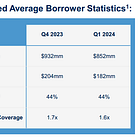A Fool's Errand: The Impossible Task of Valuing Private Credit
A Curious Case of a Failed Car Wash, and a Cautionary Tale of a BDC
Ever wonder why a company with $654 million in debt and only $1 million in cash could elude the scrutiny of its lenders until the day it declared bankruptcy? Welcome to the murky world of private credit valuations.
Strap in—we're heading to the car wash! 🏎️
But not just any car wash. We're going to Zips, a private-equity-owned, private-credit-financed chain with over 260 locations. The catch? Zips recently filed for bankruptcy, and that’s exactly why it’s our car wash of choice today.
You see, I find it curious that despite those staggering numbers, Zips' financial distress seemed to escape notice of the lenders. To understand how that happened, we'll examine the financials of some private credit funds that held Zips' debt on their books.
⁉️ Are we shocked? Not really—especially when those responsible for regulatory oversight (looking at you, SEC Commissioner) actively push back against it. But Zips isn't an isolated case—it's a symptom of a much bigger problem.
Back to the issue at hand: today, I'll explain why trying to value underlying assets in private credit funds is a fool's errand. And there's no better poster child for this problem than Prospect Capital Corporation, one of the largest Business Development Companies (BDCs) and a masterclass in what can go wrong when valuations lose touch with reality.
Invest in private credit? You need to know this:
📝A (Very) Brief Overview
Private credit funds—whether structured as BDCs, closed-end funds, or interval funds—generally operate in a similar way (I’m simplifying here, but stick with me):
A fund manager launches a fund and raises $10 million by selling 1 million shares.
The fund then originates (or purchases) five loans at $2 million each, making up the fund’s assets.
That means the NAV (net asset value) is $10 million, or $10 per share. So far, so good?
(Bonus question: how much does the fund manager collect in fees? Assuming a 2% AUM fee, that’s $200,000 per year—hold onto that number for a second.)
Fast forward three months. Borrowers make their scheduled interest payments, rates haven’t moved, and nothing material has changed.
NAV? Still $10 million ($10/share)
AUM fee? Still $200,000.
LP sentiment? Ecstatic. “No volatility, pays like clockwork—who needs liquidity anyway?”
Now, let’s imagine one of those five borrowers begins to struggle. The fund manager catches wind of trouble and needs to determine its fair value. Let’s say they’re certain the company will file for bankruptcy next quarter.






